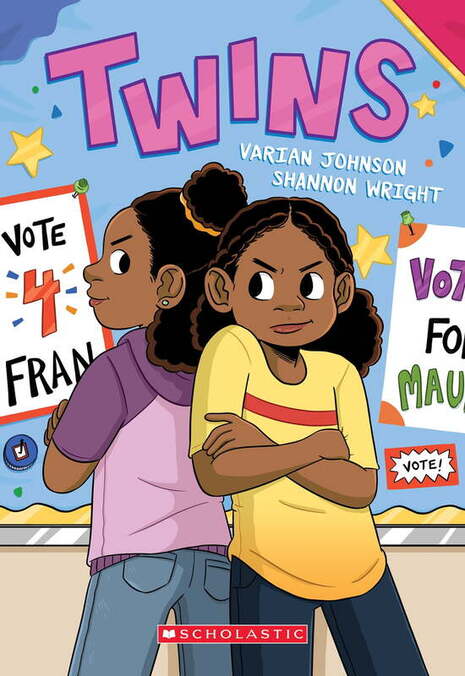|
Twins. By Varian Johnson and Shannon Wright. Scholastic/Graphix, ISBN 978-1338236132 (softcover), 2020. US$12.99. 256 pages. Last week I belatedly read Twins, a much-praised middle-grade graphic novel published by Scholastic in 2020 — a first graphic novel for both writer Varian Johnson, who is a prolific novelist, and artist Shannon Wright, who has illustrated a number of picture books (most recently, Holding Her Own: The Exceptional Life of Jackie Ormes). Twins is good, but left me wanting more. The plot concerns identical twin sisters, Maureen and Francine, who have always been close but begin to pull apart as they enter sixth grade. They end up running against each other in a student body election, a rivalry driven by mixed or confused motives that hurts their relationships with friends and family. The book boasts many nicely observed, sometimes poignant, details: novelistic good stuff. The plotting balances the twins' need for individuation against their strong bond, with a sense of earned insight for both sisters. There are astute cartooning choices along the way, including full-bleed splash pages that capture moments of struggle, hurt, and growing realization. Compositionally, Wright delivers, with emotive characters, startling page-turns, and a confident grasp of what's at stake dramatically. Twins, I admit, strikes me as more reassuring than challenging. It's on familiar middle-grade turf, with a story of girls becoming tweens and growing more sensitized to social nuances and strained friendships. There are soooo many graphic novels currently working this turf. The setting is anodyne: a comfortably middle-class suburbia with dedicated students, supportive teachers and families, wise parents, and lessons on offer about self-discipline, self-confidence, and leadership. Loose ends are tied and every arc resolved, or at least reassuringly advanced, by book's end, with no one coming off the worse. Some elements, however, seem under-thought or cliched — for instance an ROTC-like "Cadet Corps" at the school, a plot device that allows for a fierce, drill sergeant-like teacher and moments of tough discipline for the more timid of the two sisters, who of course comes out the stronger (but oh the unexamined militaristic overtones). The book is inclusive and aims to be progressive, focusing on protagonists of color (Maureen, Francine, and their family are Black) while downplaying the usual generic thematizing of racism and classism as "problems" to be suffered through (a tendency expertly spoofed by Jerry Kraft in New Kid). One scene deals with shopping while Black and implies a critique of unspoken racism, but that thread isn't woven through the whole book. That in itself might be refreshing; the book thankfully avoids potted depictions of racialized suffering and trauma. Yet for me there is too little sense of social or institutional critique; the twins' relationship and personal growth are the main things, to the point of presenting adult choices uncritically and tying up the story without any lingering sense of mystery or depths remaining to be plumbed. In a word, it's pat. Perhaps I'm guilty of wanting this middle-grade book to be more YA? That wouldn't be fair, of course. But Twins is one of so many recent graphic novels that, from my POV, appear boxed in by children's book conventions, more specifically by the rush to affirm and reassure. The contours of this kind of book are starting to seem not just clear, but rigid. Young Adult books too have their conventions, one being skepticism of adult choices and institutions, and I don't know if I'm asking for that. Perhaps what I'm wishing for is something else: a touch of mystery, maybe, or a respect for the unfinished business of living. Twins is a traditional tale well told, with all its arcs well finished and its major characters affirmed and advanced. I just can't imagine re-reading it for pleasure. Some readers will stick to the book like glue, I expect. The characterization of the twins is complex, and Maureen, who is the book's focal character and real protagonist, is especially well realized: a socially anxious nerd and academic overachiever but not a shrinking violet, not a cliché. Johnson and Wright know these characters and treat them kindly; their dialogue clicks. Plus, the art is full of smart touches, and Wright offers clear, crisp cartooning and dynamic layouts throughout. Some moments registered very strongly with me: for example, the scene early in the book where Maureen and Francine get separated at school and a page-turn finds Maureen stranded in a teeming crowd of other kids, lost. Yet the book's brightness and formulaic coloring, which favors open space, solid color fields, abstract diagonals, and color spotlights, strike me as simply functional, and in the end more busy than harmonious. While Wright excels at characters, the settings appear textureless and a bit bland. Her page designs are restless, inventive, and clever, the storytelling clear, yet the governing sensibility seems, again, generic to my eyes. It's right in the pocket for post-Raina middle-grade graphic novels, but doesn't grip me. The middle-grade graphic novel is one of the most robust areas in US publishing, and the novel of school, friendship, and social navigation is its nerve center. Twins is a fine example of that. I think I'm becoming more and more jaundiced about that kind of book, though. I can now see the outlines of a formula, and I'm getting jaded. I admit, this realization has me rethinking the bright burst of enthusiasm with which I began Kindercomics five years ago.
0 Comments
Your comment will be posted after it is approved.
Leave a Reply. |
Archives
June 2024
|



 RSS Feed
RSS Feed
